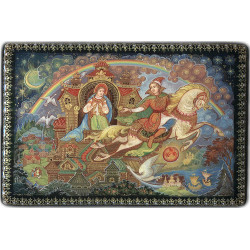No products
Product successfully added to your shopping cart
There are 0 items in your cart. There is 1 item in your cart.
KHOLUI
Catalog
New products
-

The Bronze Horseman(Monument to Peter the Great in St.Petersburg), 1965
Arist: Karapaev Yuriy(1936-2009); Size: 9x13.5x5
$425.00 -

The Bronze Horseman(Monument to Peter the Great in St.Petersburg)
Arist: Gordeev V.; Size: 9.5x6.5
$375.00 -

-

-

-

-

-

The old Russian village of Kholui (located in Ivanovo region) is known for it's remarkable scenic beauty. This unique corner of Russia seems to have been created precisely to astound the world with it's original charm. The clear blue waters of the river of Teza reflect the silvery boughs of the bordering willows and the domes of the white-stone 17th century Trinity Church.
In the spring river overflows it's banks flooding the whole district and turning the streets into real canals. Boats are used to get about the village--to kinder-garden, school or work. The high waters stays all of April. Then the land quickly dons it's verdant garb looking more attractive than ever after it's rejuvenating spring "wash" and inspiring the artists to new poetic landscapes.
Kholui is also famous for its old history.
The first mentioned in 1546 in Ivan the Terrible's deed it was granted fifty years later to Dmitriy Pozharsky by the Tsar of Moscow principality for his services to the country. One mile away from Kholui is the 18th century architectural monument--the complex of the former monastery "Borkovskaya Pustyn" founded and financed by Princes Pozharsky.
From times ago past icon painting was a hereditary occupation. The village's convenient location afforded close links with many towns of the state of Moscow and promoted the reproduction of the icons for the market. These were chiefly "popular" icons that required no special workmanship. Yet there were also pieces executed on a high artistic level boasting magnificent scripture and virtuoso chasing work on a gold ground.
The history of lacquer miniature in Kholui is very similar to Palekh and Mstera.
In 1931 the Mstera Branch of an art artel specializing in rug painting was set up in Kholui, and on July 1st, the 1934 it was developed into an art artel. it's more gifted icon painters, among them S.Mokin,K.Kosterin,M.Dobrynin and V.Puzanov-Molev began to paint lacquer objects of papier-mache made after Fedoskino technology.
In 1935 a school of team-apprenticeship was opened under the artel which was later re-organized in into Kholui vocational school. Over a thousand specialists for artistic folk crafts were trained in this unique educational establishment.
The final emergence of the new Kholui style took place in the 1940's. In those years many works of historical subjects were created by K.Kosterin,S.Mokin and Puzanov-Molev.
Kholui art is distinguished for it's more concrete and picturesque character as compared to Palekh and Mstera.It employs a wide range of warm ground colors , with preference for yellows, browns and reds, joined with a sparing ornament. In distinction from Mstera the Kholui landscapes lacks the formers light-colored receding prospects and comes out as an element than underlines and deepens the content; it is often symbolic. Kholui art also depicts figures on a large scale.
Kholui miniatures are more realistic, compares to Palekh's and Mstera's ones, but yet more decorative than those of Fedoskino. Their stylistic features were displayed to the best advantage in the landscape genre.
The art of Kholui miniature is the youngest of all the Russian lacquer crafts. in 1947 the artel welcomed the first graduates from vocational art school, those who form it's artistic nucleus today: V.Belov,V.Fomin, Nikolay Babrin, B.Tikhonravov, Boris Kiseleov,Nikolay Denisov,A.Kosterin,A.Kamorin.
The younger Kholui painters such as Viktor Yolkin,Vladimir Sedov,Alexander Smirnov, Piotr Mityashin, A. Sotskov and N.Shevtsov are working in the finest traditions of the older generation and some of them became teachers in Kholui Art School.
KHOLUI There are 105 products.
Tale of Ivan Bykovich
Please let us know if you have any questions about this box.
$475.00 $595.00In StockTown of Suzdal and village of Dunilovo...
Well-known artist Boris Kiriyanov of Kholui is a talent behind this interesting dual-sided box. On one of the sides of the box the artist has depicted a panoramic view of town of Suzdal and the other one- a view of the village of Dunilovo, which located not far from Ivanovo and Shuya.
$750.00 $950.00In StockTown of Suzdal
Well-known artist Boris Kiriyanov of Kholui is a talent behind this interesting box. The artist has depicted a panoramic view of town of Suzdal. The sides of the box are also have very detailed views of Suzdal.
$350.00 $450.00In StockEmelya and the Magic Fish
This interesting box shows one of the key episodes from the popular Russian fairy-tale "By the Pike's Will" or "Emelya and the Magic Pike".
$950.00In StockSivka-Burka
This incredible box was painted by the highly talented family tandem Yevgeniy and Svetlana Vlasovs.
$690.00 $790.00In StockTown of Suzdal
Talented artist Makarycheva Tatiana of Kholui has painted this detailed box.
$140.00In StockSnowmaiden
Talented Kholui artist Lapshina Elena has painted this beautiful work. The colors that she chose fully represent the theme depicted. The box almost appears cold to the touch. The subject of this scene is based on the popular Russian fairy-tale "Snowmaiden".
$100.00 $175.00In StockThe Royal Hunt
Mikhail Veselov of Kholuy is the artist who painted this box. He is a talented artist whose style is enhanced by the ultra-thin brushwork he manages to render. There are a few artists who have the ability to make the smallest strokes of paint come to life, and he is in this handful of famous Kholuy names. This work is no exception.
$1,199.00 $1,495.00In StockViews of Moscow
This impressive large five-sided casket has the painting on four of it's sides and the lid. The artist of this magnificent work is Makarychev Alexander from the village of Kholui. It is another piece from his series of architectural works.
$750.00 $875.00In Stock


























